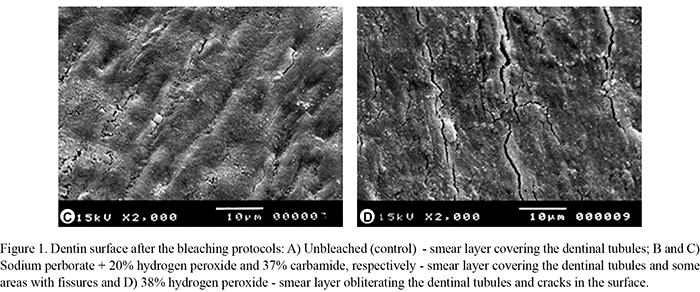This study evaluated the effect of bleaching agents on bond strength at the dentin/resin interface and the flexural strength of dentin. Forty maxillary canines were selected for the study. In the shear strength test, 40 slabs of intracoronary dentin (5 x 5 mm) obtained from buccal surfaces of the crowns were included in acrylic resin. In the flexural strength test, 40 dentin bars (8 x 2 x 2 mm) were obtained from the roots. The 40 hemi-sections of the lingual surface were prepared for scanning electron microscopy (SEM). The specimens were divided into 4 groups according to the bleaching protocol (n=10): Unbleached (control), Sodium perborate + 20% hydrogen peroxide (SP + 20% HP), 37% carbamide peroxide (37% CP) and 38% hydrogen peroxide (38% HP). After 7 days, the bond strength specimens were restored and tested. Dentin bars were bleached and subjected to a three-point bending test. Data (MPa) were analyzed by ANOVA and Tukey's test (α=0.05). In the shear test, the control group was superior (p<0.05) to the bleached groups, which, in turn, were statistically similar (p>0.05). In the flexural strength test, the control group also had the highest values and differed significantly from the other groups (p<0.05). SEM revealed smear layer in all groups, with fissures in the bleached specimens. SP + 20% HP and 38% HP showed discontinuous interfaces with few tags. In conclusion, bond strength of restorative material to dentin and flexural strength of dentin were reduced after the use of high-concentration bleaching agents.
adhesion; flexural strength; bleaching and dentin






